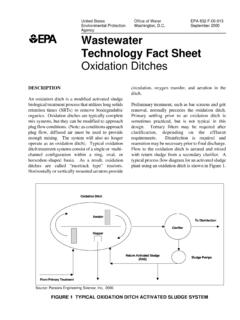Transcription of Step-By-Step Wastewater Treatment
1 BUTLER AREA SEWER AUTHORITY 100 LITMAN ROAD BUTLER, PA 16001-3256 (724) 282-1978 Step-By-Step Wastewater Treatment Step 1: Raw Sewage enters the plant from public and private customers. Step 2: The Sewage first passes through mechanical bar screens. This combs out any large debris such as rags, cloths, wood, plastics, or other large objects. Step 3: The sewage then enters aerated grit chambers. Air is pumped into the Wastewater which suspends lighter materials and allows heavier solids, or grit to settle out. Grit includes materials, such as egg shells or sand, which will not decompose or break down readily. Step 4: Next, Wastewater is diverted into five sedimentation tanks. While there, the velocity of the sewage flow is slowed down to allow some material to float to the top or sink to the bottom, where it is collected and sent to solids Treatment . Step 5: The Wastewater is now clean of most of the larger suspended solids and now passes through a trickling filter.
2 A trickling filter is a large-diameter, cylindrical structure filled with stone. As the primary effluent is distributed over the stone, a biological slime grows on the rocks and breaks down organic materials. During this process 90% or more of the suspended solids and BOD (Biochemical Oxygen Demand) are removed. Step 6: The water then goes into aeration tanks where an activated sludge process occurs. Aerobic microorganisms remove soluble or finely divided suspended organic material. Step 7: The microorganism-filled water then goes into a secondary settling tank where the organisms settle at the bottom of the tank. The settled solids are returned to the aeration tank as activated sludge to act as a microorganism seeding process, or sent to solids Treatment . Step 8: Next, the water enters chlorine contact tanks where chlorine is injected into the water. The chlorine disinfects the water, which destroys pathogenic microorganisms.
3 This process prevents disease by protecting public water supplies, receiving waters for recreation uses, and shellfish growing areas. Step 9: Finally, the water is released into the Connoquenessing Creek as treated effluent . Step-By-Step Solids Treatment Step 1: Sludge solids that are collected at the top and bottom of the primary and secondary sedimentation tanks are pumped into a sludge thickener. Here the liquid volume of the sludge is decreased to increase the efficiency of the sludge Treatment process. Excess liquid is diverted back into the system. Step 2: The thickened sludge is then pumped into a lime stabilization tank. Raw sludge that enters the lime stabilization tank has very high amounts of pathogenic microorganisms. This process combines large amounts of lime with the sludge to increase the pH to 12 or more killing potentially harmful pathogens. Step 3: The stabilized sludge is then pumped to a filter press.
4 In the filter press, water is squeezed out of the liquid sludge to form a sludge cake which is relatively dry. The sludge cake is then combined with the grit from the aerated grit chambers and hauled to a sanitary landfill for disposal. Primary Treatment (physical) Secondary Treatment (biological) Revised 8-8-08

